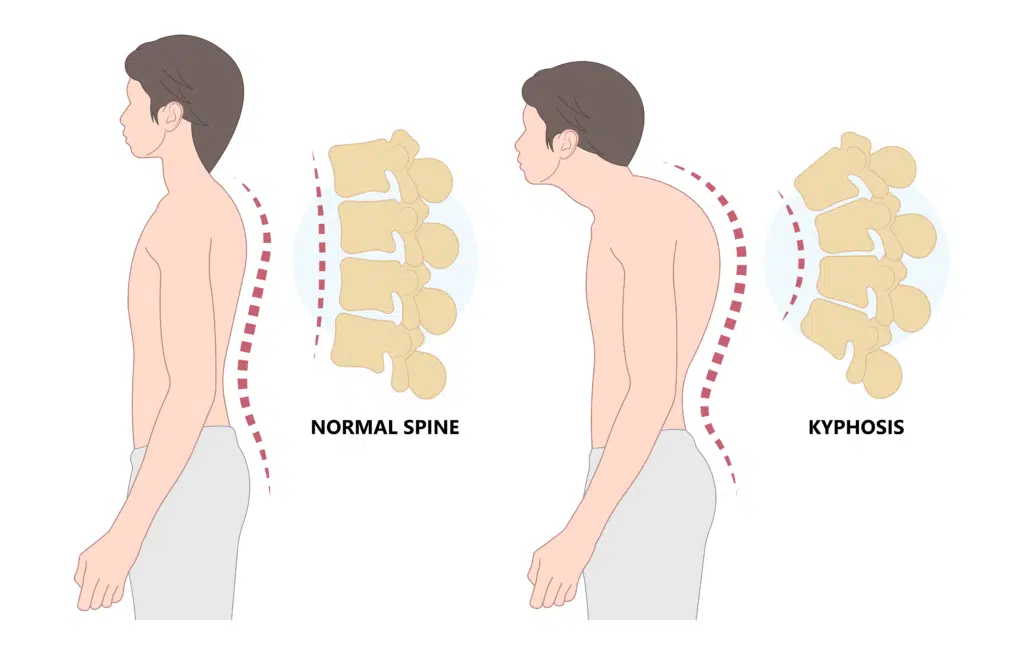
Kyphosis
Your spine has natural curves that support your posture and help you stand straight. However excessive curvature can affect your body and make your posture difficult. Kyphosis does not usually cause health problems or require medical treatment but it can make you feel awkward and un comfortable about how you look. A severe case of kyphosis may require surgery and postural training.
Overview
A visible forward curve in the upper part of the spine is the primary sign of kyphosis, a term derived from the Greek word 'kyphos', meaning hunch. It gives the upper back a curved appearance with the shoulders rounded forward. The thoracic spine has a normal forward curvature known as "kyphosis " that ranges from 20 to 50 degrees. This forward curvature is mirrored by reverse curvatures (known as "lordosis") in the cervical spine (the neck) and lumbar spine (the lower back).
The spine's combination of forward and reverse curves allows people to sit and stand upright. Technically kyphosis refers to any exaggerated rounding of the forward curvature of the upper back but the term "kyphosis" is commonly used to refer to the clinical condition of excess curvature of the upper back greater than 50 degrees resulting in a stooped forward posture.
Causes
Congenital kyphosis: Doctors are unsure why some children are born with this condition.
Postural kyphosis: This occurs in many people, particularly those who spend a lot of time looking down, such as at schoolwork or on a phone.
Scheuermann's kyphosis: Runs in families.
Cervical kyphosis (military neck): This occurs when the cervical spine curves towards the front rather than its natural curve to the back.
Hyperkyphosis: This is a severe forward curvature of the spine. The curve is more than 50 degrees long. Occurs more after the age of 40.
Symptoms
Rounded shoulders are the most common kyphosis symptoms.
A hump or curve in your upper back. Hamstring strain (muscles in the back of your thighs).
The following symptoms may be caused by severe kyphosis:
Back and shoulder blade pain or stiffness.
Legs that are numb weak or tingly.
Extreme exhaustion.
Concerns about balance.
Incontinence of the bladder or bowel.
Breathing difficulties or shortness of breath.
Ayurvedic View
Kati gata vata- In this disease, when aggravated vata dosha reach to spine and causes dushti of asthi (bone and supporting structures) leading to change in normal curvature of spine, this is kyphosis. Ayurveda way of approach is to correct dosha imbalance, nourish the dhatus (bone ligament,tendon,muscle) and bring back the lost normal curvature of spine and reduce the associated complaints arising due to this disease, by ayurvedic panchakarma treatment and local treatment done to kati (spine).
Ayurvedic Treatments
Matra vasti Abhyangam Kashaya vasti Churna pinda swedanam Patra pinda swedanam. Navara pinda swedanam Prishta vasti Pizzhichal
Naturopathy Treatments
Spinal Bath Spinal spray Immersion baths chiropractic Physiotherapy Electrotherapy Cupping therapy Dorn therapy
Kyphosis
Treatment for
DISCLAIMER: Listed treatment details are only for information purposes. Treatments and duration may vary depending on numerous factors. Treatments for your condition may not be limited to this list.






















